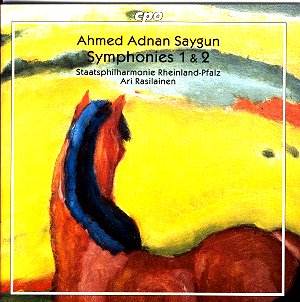This valuable release of two symphonies by Turkish composer
Ahmed Adnan Saygun significantly augments his discography. Saygun's music
straddles Turkish and Western European musical traditions, being influenced
by his studies on the ud (a plucked string instrument) and the piano,
and also by his marrying of Turkish modal scales with a Neo-Classical
outlook. Like Bartok, Saygun was fascinated by the folk music of his native
country (in fact, the two composers co-operated on a study of Anatolian
folk music, on which Saygun penned an article, 'Bela Bartók's Folk
Music Research in Turkey').
Saygun's First Symphony dates from 1953. Not only can
one hear the synthesis of East and West, but the influence of Neo-Classicism
is also marked. Each of the four movements is modelled on a pre-established
formal structure (namely Sonata Form; Passacaglia; Minuet; Variations).
The first movement exhibits unmistakably Eastern European undertones
embedded within a Romantic, Western tradition.
The figure of Bartók looms large in the monophonic
opening of the second movement 'Passacaglia', above which a beautifully-played
oboe solo floats. This movement is in fact the highlight of the piece,
Saygun gradually adding lines to the texture to make the climax an inevitability.
The oboe solo which ensues is all the more powerful because of the dynamic
contrast. Saygun's musical language is at its most concentrated in this
movement, and it receives an appropriately concentrated performance
to match.
Notwithstanding some scrappy string playing, the performance
standard is high and the recording more than acceptable. The durational
proportions of the movements is unbalanced, however: the first two movements
each last just under ten minutes each, the third is just over three
and the finale just over five minutes. This is a fault the companion
work on this disc does not suffer from.
A mere four years separates these two symphonies (amongst
other works, the Partita for Solo Cello, Op. 31, the Three Ballads for
Voice and Piano, Op. 32 and the Suite for Violin and Piano, Op. 33 also
date from this period). Saygun uses a larger orchestra and thereby expands
his palette in his Second Symphony (dedicated to his father, Mohamed,
who died in 1954). Although sharing several traits with the its predecessor,
this piece is more mature, very much in balance with itself (all four
of its movements are between 6 and 8 minutes duration).
Again, the second movement is the finest, replete with
intense, modal melodies. The scoring is dense but never overcrowded:
Rasilainen and his orchestra commendably clarify the musical argument,
aided by the transparent recording. Neo-classicism is most evident in
the contrasting third movement, characterised by a Baroque siciliano
rhythm.
All praise, then, to CPO for bringing these works to
the record-buyer's attention, and to the Rheinland-Pfalz orchestra (translated
as the Rhineland-Palatinate State Philharmonic Orchestra in the booklet)
for their dedication to promoting Saygun's music. This disc is certainly
worthy of investigation.
Colin Clarke
Also see review
by Rob Barnett


